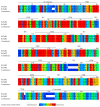The Controversial C5a Receptor C5aR2: Its Role in Health and Disease
- PMID: 28706957
- PMCID: PMC5494583
- DOI: 10.1155/2017/8193932
The Controversial C5a Receptor C5aR2: Its Role in Health and Disease
Erratum in
-
Corrigendum to "The Controversial C5a Receptor C5aR2: Its Role in Health and Disease".J Immunol Res. 2017;2017:6073961. doi: 10.1155/2017/6073961. Epub 2017 Nov 1. J Immunol Res. 2017. PMID: 29226158 Free PMC article.
Abstract
After the discovery of the C5a receptor C5aR1, C5aR2 is the second receptor found to bind C5a and its des-arginine form. As a heptahelical G protein-coupled receptor but devoid of the intracellular Gα signal, C5aR2 is special and confusing. Ramifications and controversies about C5aR2 are under debate since its identification, from putative ligands and cellular localization to intracellular signals and pathological roles in inflammation and immunity. The ruleless and even conflicting pro- or anti-inflammatory role of C5aR2 in animal models of diverse diseases makes one bewildered. This review summarizes reports on C5aR2, tries to clear up available evidence on these four controversial aspects, and delineates C5aR2 function(s). It also summarizes available toolboxes for C5aR2 study.
Figures

Similar articles
-
Structure and characterization of a high affinity C5a monoclonal antibody that blocks binding to C5aR1 and C5aR2 receptors.MAbs. 2018 Jan;10(1):104-117. doi: 10.1080/19420862.2017.1384892. Epub 2017 Oct 24. MAbs. 2018. PMID: 28952876 Free PMC article.
-
The Novel Receptor C5aR2 Is Required for C5a-Mediated Human Mast Cell Adhesion, Migration, and Proinflammatory Mediator Production.J Immunol. 2015 Sep 15;195(6):2774-87. doi: 10.4049/jimmunol.1401348. Epub 2015 Aug 17. J Immunol. 2015. PMID: 26283482
-
Characterization of Anaphylatoxin Receptor Expression and C3a/C5a Functions in Anaphylatoxin Receptor Reporter Mice.Curr Protoc Immunol. 2020 Sep;130(1):e100. doi: 10.1002/cpim.100. Curr Protoc Immunol. 2020. PMID: 32710701
-
Differential effects of anaphylatoxin C5a on antigen presenting cells, roles for C5aR1 and C5aR2.Immunol Lett. 2019 May;209:45-52. doi: 10.1016/j.imlet.2019.03.014. Epub 2019 Apr 5. Immunol Lett. 2019. PMID: 30959077 Review.
-
New concepts on the therapeutic control of complement anaphylatoxin receptors.Mol Immunol. 2017 Sep;89:36-43. doi: 10.1016/j.molimm.2017.05.015. Epub 2017 May 30. Mol Immunol. 2017. PMID: 28576324 Review.
Cited by
-
Identification of a genetic region linked to tolerance to MRSA infection using Collaborative Cross mice.PLoS Genet. 2024 Aug 23;20(8):e1011378. doi: 10.1371/journal.pgen.1011378. eCollection 2024 Aug. PLoS Genet. 2024. PMID: 39178306 Free PMC article.
-
Significance of Complement System in Ischemic Stroke: A Comprehensive Review.Aging Dis. 2019 Apr 1;10(2):429-462. doi: 10.14336/AD.2019.0119. eCollection 2019 Apr. Aging Dis. 2019. PMID: 31011487 Free PMC article. Review.
-
Neutrophils from ANCA-associated vasculitis patients show an increased capacity to activate the complement system via the alternative pathway after ANCA stimulation.PLoS One. 2019 Jun 19;14(6):e0218272. doi: 10.1371/journal.pone.0218272. eCollection 2019. PLoS One. 2019. PMID: 31216309 Free PMC article.
-
Complement C3 activation regulates the production of tRNA-derived fragments Gly-tRFs and promotes alcohol-induced liver injury and steatosis.Cell Res. 2019 Jul;29(7):548-561. doi: 10.1038/s41422-019-0175-2. Epub 2019 May 10. Cell Res. 2019. PMID: 31076642 Free PMC article.
-
Role of C5aR1 and C5L2 Receptors in Ischemia-Reperfusion Injury.J Clin Med. 2021 Mar 2;10(5):974. doi: 10.3390/jcm10050974. J Clin Med. 2021. PMID: 33801177 Free PMC article.
References
-
- Klos A., Wende E., Wareham K. J., Monk P. N. International Union of Basic and Clinical Pharmacology. [corrected]. LXXXVII. Complement peptide C5a, C4a, and C3a receptors. Pharmacological Reviews. 2013;65(1):500–543. - PubMed
Publication types
MeSH terms
Substances
LinkOut - more resources
Full Text Sources
Other Literature Sources
Research Materials

